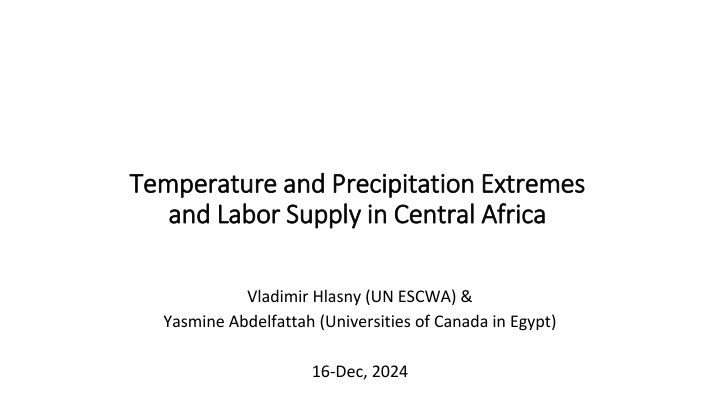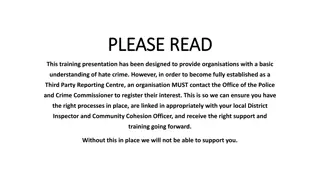Combatting Online Misogyny: Women's Battle Against Hate Speech
Online spaces can be hostile environments for women, who often face various forms of hate speech and harassment. Research highlights the psychological impact of online abuse on women, leading to stress, anxiety, and self-censorship. Despite these challenges, women are urged to support each other, share experiences, and resist attempts to silence them. Digital feminism emerges as a tool to address the misogyny prevalent in online spheres.
Download Presentation

Please find below an Image/Link to download the presentation.
The content on the website is provided AS IS for your information and personal use only. It may not be sold, licensed, or shared on other websites without obtaining consent from the author.If you encounter any issues during the download, it is possible that the publisher has removed the file from their server.
You are allowed to download the files provided on this website for personal or commercial use, subject to the condition that they are used lawfully. All files are the property of their respective owners.
The content on the website is provided AS IS for your information and personal use only. It may not be sold, licensed, or shared on other websites without obtaining consent from the author.
E N D
Presentation Transcript
Temperature and Precipitation Temperature and Precipitation Extremes and and Labor Supply in Central Africa Labor Supply in Central Africa Extremes Vladimir Hlasny (UN ESCWA) & Yasmine Abdelfattah (Universities of Canada in Egypt) 16-Dec, 2024
Motivation Africa is one of the world s regions most vulnerable to climate change. This calls for a deeper understanding of the consequences, risks and mitigation measures. Prior literature has examined the impacts of extreme weather events in different parts of Africa on demography, migration, production and agriculture, and labor supply. We hope to contribute up-to-date evidence by assessing the effects of extreme temperature & precipitation levels on working hours, of less or more exposed workers, across 4 Central African countries with multiple rounds of High Frequency Phone Surveys for 2020 2023.
Research Questions How does climate change as measured by temperature, humidity and precipitation extreme values impact labor supply in Central Africa? Which manifestation exerts the most series impacts, and are there safe or threshold levels with respect to the impacts? Does this impact differ between occupations with high versus low exposure to weather?
Datasets used Longitudinal survey data from the 2020 2023 LSMS High Frequency Phone Surveys for Malawi (rounds 13,14,18), Nigeria (rounds 2 20), Tanzania (rounds 2 8), and Uganda (rounds 2 14), screening hours worked in the past week in one s main job. XXX Individual respondents from XXX districts (XXX sub-districts) over XXX weeks. Globally gridded weather & climate datasets: NASA Prediction of Worldwide Energy Resource (POWER) Project, funded through the NASA Applied Sciences Program for relative humidity. Daily data from closest weather stations mappable to HFPS respondents or their (sub-)district. Global Administrative Areas (GADM) shapefiles based on Humanitarian Data Exchange.
Weekly hours worked in current job by national district, by gender Men typically work longer hours than women, Tanzanians longer than Malawians Malawi Nigeria Tanzania Uganda Source: Authors analysis based on 2020 2023 HFPS for Malawi (rounds 13,14,18), Nigeria (rounds 2 20), Tanzania (rounds 2 8), and Uganda (rounds 2 14). National panel sampling weights are used. GADM shapefiles based on Humanitarian Data Exchange (2024).
Weekly hours worked in current job, by gender Men Women Source: Authors analysis based on 2020 2023 HFPS for Malawi (rounds 13,14,18), Nigeria (rounds 2 20), Tanzania (rounds 2 8), and Uganda (rounds 2 14). National panel sampling weights are used.
Weekly hours worked vary by year perhaps according to the dry/wet seasons surveyed Malawi Nigeria Tanzania Uganda Source: Authors analysis based on 2020 2023 HFPS for Malawi (rounds 13,14,18), Nigeria (rounds 2 20), Tanzania (rounds 2 8), and Uganda (rounds 2 14). National panel sampling weights are used. GADM shapefiles based on Humanitarian Data Exchange (2024).
Weekly average of daily maximum temperature by national district Malawi Nigeria Tanzania Uganda Source: Authors analysis using NASA POWER. GADM shapefiles based on Humanitarian Data Exchange (2024).
Weekly precipitation by national district Malawi Nigeria Tanzania Uganda Source: Authors analysis using NASA POWER. GADM shapefiles based on Humanitarian Data Exchange (2024).
Weekly relative humidity by national district Malawi Nigeria Tanzania Uganda Source: Authors analysis using NASA POWER. GADM shapefiles based on Humanitarian Data Exchange (2024).
Malawi (dry season) Malawi (wet season) Nigeria (dry season) Nigeria (wet season) Tanzania (dry season) Tanzania (wet season) Uganda (dry season) Uganda (wet season) Men Lab force part Employed Hours worked Max temper. Precipitation Relat humidity 88.33% 74.11% 32.38 27.58C 86.87% 77.58% 31.95 29.78C 90.68% 77.45% 36.47 88.71% 73.99% 35.17 81.72% 63.38% 42.51 99.89% 81.80% 39.23 100.00% 85.06% 34.69 80.92% 73.26% 35.81 Women Lab force part Employed Hours worked Max temper. Precipitation Relat humidity 86.65% 63.61% 26.21 27.49C 87.02% 69.77% 26.33 29.92C 82.01% 59.51% 33.07 84.39% 61.45% 32.20 81.73% 53.76% 39.37 99.88% 64.88% 37.28 100.00% 75.84% 33.87 83.95% 69.60% 33.86
Research Framework We utilize the conventional econometric framework from prior studies (Zivin & Neidell 2014; Shayegh et al. 2020; Abou-Ali et al. 2022) as follows: 2+ ?????+ ?1? +?2?2+??+ ???? ????= ?0+ ?1?? ????+ ?2?? ???? ????is the respondent i s labor supply in location s during week t. Weather indicators are (1) average of the maximum weekly temperature faced by respondents in week t in location s; (2) average humidity faced by respondents in week t in location s; (3) average precipitation faced by respondents in week t in location s. ????is a vector of individual/district-level characteristics which are controlled for including exposed sector, potential work experience, experience squared, employment type, gender, HHD size, HHD size squared, rainy season. ?, ?2, ??are time trend, trend squared, and district fixed effects, respectively. Exposed-sector is interacted with extreme weather indicators
Estimators Alternative dependent variables are employment status, and hours worked in the past week Because these are limited dependent variables, we use the corresponding estimators: probit for employment status, and tobit (treating hours worked as continuous but left-censored) or negative binomial regression (treating hours as an over- dispersed count variable). A within estimator with individual-level random or fixed effects is used to offset autocorrelation & latent heterogeneity across workers.
Neg Logit Neg Logit Tobit (Hours) -4.368* (2.246) 0.236* (0.135) 0.029 (0.081) -0.000 (0.000) 0.591 (1.056) -0.009 (0.008) -8.688 (23.888) -0.042 (0.853) 0.013 (0.035) 0.000 (0.293) Tobit binomial (Hours) -0.127* (0.071) 0.006 (0.004) 0.001 (0.002) -0.000 (0.000) 0.015 (0.029) -0.000 (0.000) -0.268 (0.627) 0.008 (0.024) 0.000 (0.001) -0.001 (0.008) (Employed), FE -0.097*** (0.000) 0.004*** (0.000) -0.001*** (0.000) 0.000*** (0.000) 0.043*** (0.000) -0.000*** (0.000) 0.268*** (0.004) -0.065*** (0.000) -0.000*** (0.000) -0.000*** (0.000) binomial (Hours), FE -0.283*** (0.001) 0.014*** (0.000) -0.000 (0.000) 0.000*** (0.000) 0.066*** (0.001) -0.001*** (0.000) -1.761*** (0.011) 0.050*** (0.000) -0.002*** (0.000) 0.018*** (0.000) (Employed) -0.127 (0.188) 0.013 (0.010) -0.005 (0.021) -0.000 (0.000) 0.085 (0.116) -0.000 (0.001) -0.184 (2.682) 0.033 (0.121) 0.013 (0.011) -0.013 (0.032) (Hours), RE -4.437*** (0.025) 0.213*** (0.002) 0.024*** (0.001) -0.000*** (0.000) 0.810*** (0.015) -0.012*** (0.000) -18.651*** (0.270) 0.024** (0.010) -0.008*** (0.000) 0.136*** (0.003) Malawi, Men Max temperature Max tempertr. Squared Avg precipitation Avg precipitat squared Relat humidity Relat humidity squared Vulnerable sector Vulnerable x temperature Vulnerable x precipitation Vulnerable x humidity
Neg Logit Neg Logit Tobit (Hours) 0.051 (2.611) 0.113 (0.171) -0.098 (0.094) 0.000 (0.000) 0.396 (1.694) -0.002 (0.013) 28.344 (28.221) -0.763 (1.038) 0.058 (0.045) -0.462 (0.343) Tobit binomial (Hours) -0.028 (0.102) 0.005 (0.007) -0.003 (0.003) 0.000 (0.000) 0.019 (0.055) -0.000 (0.000) 0.864 (0.944) -0.018 (0.035) 0.002 (0.001) -0.016 (0.011) (Employed), FE -0.097*** (0.000) 0.004*** (0.000) -0.001*** (0.000) 0.000*** (0.000) 0.043*** (0.000) -0.000*** (0.000) 0.268*** (0.004) -0.065*** (0.000) -0.000*** (0.000) -0.000*** (0.000) binomial (Hours), FE 0.158*** (0.002) -0.008*** (0.000) -0.006*** (0.000) 0.000*** (0.000) 0.153*** (0.002) -0.001*** (0.000) 1.787*** (0.022) 0.002** (0.001) 0.008*** (0.000) -0.032*** (0.000) (Employed) -0.113 (0.166) 0.016 (0.010) 0.022* (0.013) -0.000** (0.000) 0.330*** (0.124) -0.002** (0.001) 5.982** (2.626) -0.157 (0.114) 0.009 (0.007) -0.079*** (0.030) (Hours), RE 0.978*** (0.032) 0.073*** (0.002) -0.112*** (0.001) 0.000*** (0.000) 0.442*** (0.021) -0.001*** (0.000) 30.539*** (0.337) -0.813*** (0.012) 0.065*** (0.001) -0.504*** (0.004) Malawi, Women Max temperature Max tempertr. Squared Avg precipitation Avg precipitat squared Relat humidity Relat humidity squared Vulnerable sector Vulnerable x temperature Vulnerable x precipitation Vulnerable x humidity
Neg Logit Neg Logit Tobit (Hours) 0.116 (0.788) -0.032 (0.029) 0.001 (0.002) -0.000 (0.000) -0.091 (0.087) 0.001 (0.001) -2.411 (6.019) -0.264 (0.303) -0.001 (0.001) -0.049 (0.046) Tobit binomial (Hours) -0.014 (0.030) -0.001 (0.001) 0.000 (0.000) -0.000 (0.000) -0.002 (0.003) 0.000 (0.000) 0.054 (0.198) -0.012 (0.010) -0.000 (0.000) -0.003* (0.001) (Employed), FE -0.097*** (0.000) 0.004*** (0.000) -0.001*** (0.000) 0.000*** (0.000) 0.043*** (0.000) -0.000*** (0.000) 0.268*** (0.004) -0.065*** (0.000) -0.000*** (0.000) -0.000*** (0.000) binomial (Hours), FE 0.037*** (0.000) -0.001*** (0.000) -0.000*** (0.000) 0.000*** (0.000) -0.001*** (0.000) 0.000*** (0.000) -0.063*** (0.001) -0.003*** (0.000) -0.000*** (0.000) -0.001*** (0.000) (Employed) -0.114 (0.095) 0.004 (0.003) -0.001*** (0.000) 0.000** (0.000) 0.049*** (0.010) -0.000*** (0.000) -0.131 (0.695) -0.046 (0.036) 0.000** (0.000) 0.000 (0.005) (Hours), RE 0.024*** (0.003) -0.014*** (0.000) -0.002*** (0.000) 0.000*** (0.000) -0.078*** (0.000) 0.002*** (0.000) -1.674*** (0.025) -0.248*** (0.001) -0.001*** (0.000) -0.028*** (0.000) Nigeria, Men Max temperature Max tempertr. Squared Avg precipitation Avg precipitat squared Relat humidity Relat humidity squared Vulnerable sector Vulnerable x temperature Vulnerable x precipitation Vulnerable x humidity
Neg Logit Neg Logit Tobit (Hours) -1.001 (1.293) 0.014 (0.047) 0.005 (0.004) -0.000 (0.000) -0.068 (0.164) -0.000 (0.002) -10.078 (9.675) -0.351 (0.449) 0.000 (0.002) 0.055 (0.078) Tobit binomial (Hours) -0.049 (0.048) 0.001 (0.002) 0.000 (0.000) -0.000 (0.000) 0.001 (0.005) -0.000 (0.000) 0.175 (0.374) -0.033* (0.018) -0.000 (0.000) -0.003 (0.003) (Employed), FE -0.097*** (0.000) 0.004*** (0.000) -0.001*** (0.000) 0.000*** (0.000) 0.043*** (0.000) -0.000*** (0.000) 0.268*** (0.004) -0.065*** (0.000) -0.000*** (0.000) -0.000*** (0.000) binomial (Hours), FE 0.055*** (0.000) -0.002*** (0.000) 0.000*** (0.000) -0.000*** (0.000) -0.002*** (0.000) 0.000*** (0.000) -0.633*** (0.002) 0.017*** (0.000) -0.000*** (0.000) 0.002*** (0.000) (Employed) -0.184 (0.131) 0.008* (0.005) 0.000 (0.000) -0.000 (0.000) 0.037** (0.015) -0.000* (0.000) 0.241 (0.943) -0.016 (0.048) 0.000 (0.000) -0.000 (0.007) (Hours), RE 0.709*** (0.006) -0.034*** (0.000) -0.001*** (0.000) 0.000*** (0.000) -0.160*** (0.001) 0.002*** (0.000) -16.007*** (0.050) 0.206*** (0.002) 0.001*** (0.000) 0.107*** (0.000) Nigeria, Women Max temperature Max tempertr. Squared Avg precipitation Avg precipitat squared Relat humidity Relat humidity squared Vulnerable sector Vulnerable x temperature Vulnerable x precipitation Vulnerable x humidity
Results summary In Malawi, Extreme heat clearly affects men's labor supply adversely (at a diminishing rate), but has an uncelar effect on women. Precipitation affects labor supply of both genders negatively, but weakly. Relative humidity appears to affect it positively for both genders (at a diminishing rate). Sectors a priori identified as vulnerable might be affected more adversely but evidence is not conclusive. There are level and slope differences between genders. In Nigeria, the estimated effects are weaker and less significant or clear. There is weak evidence that men in vulnerable sectors are affected worse than in other sectors.
Policy Implications Given that most of the strategically important activities in the region are considered to be high-risk with relatively more exposure to extreme weather, our study emphasizes the importance of understanding the relationship between changes in climate conditions and labor supply & productivity. This calls for serious attention and immediate action from policy makers towards the pressing issues of climate change since this could ultimately have a negative impact on the regional economies.
Future Work Given the results weakness, we will focus on getting the relationship right. Could the responses be nonlinear or step functions? Given the potential effect of COVID-19 lockdowns on labor supply, and the potential interactions between weather extremes and COVID- 19 eruptions, this nexus will be explored. We hope to get extreme weather data at a more granular level, at sub-district or respondent location. For completeness, we will supplement this work with analysis of employment status in Burkina Faso and Ethiopia.


![Prevention and Combating of Hate Crimes and Hate Speech Bill [B.9B.2018]](/thumb/60513/prevention-and-combating-of-hate-crimes-and-hate-speech-bill-b-9b-2018.jpg)




















